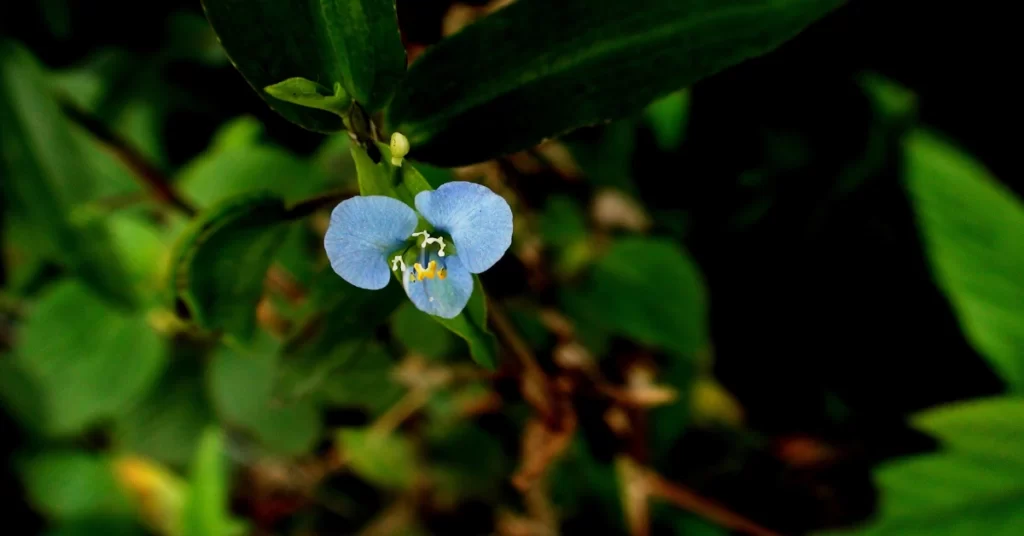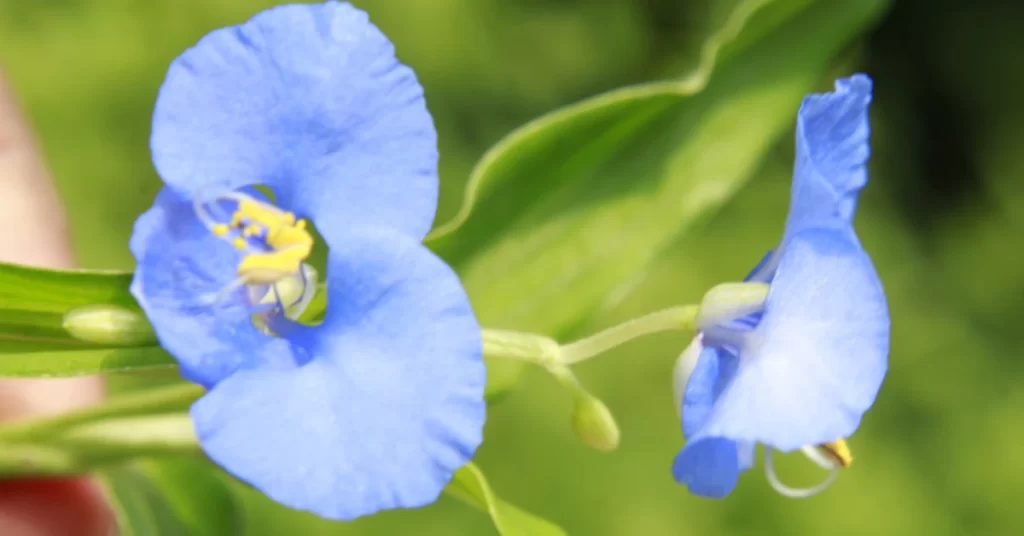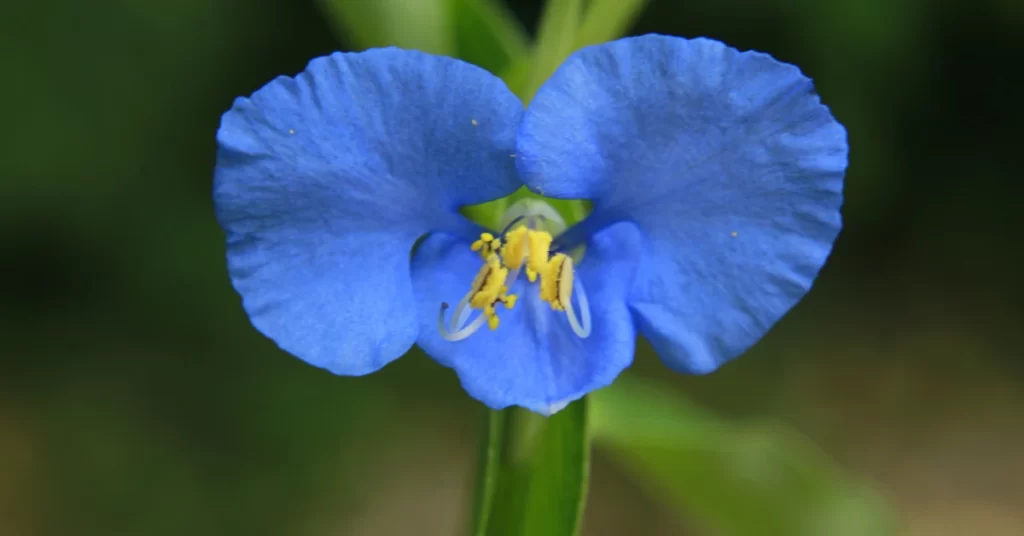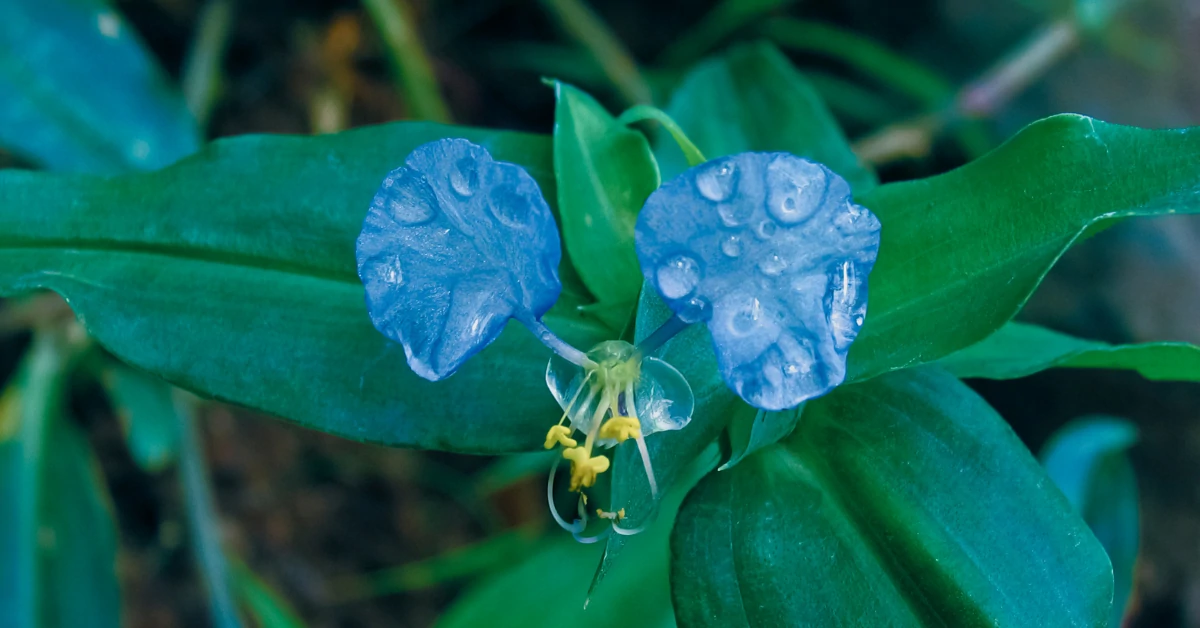Commelina benghalensis, also known as the tropical spiderwort or Bengal dayflower, is a fast-growing, hardy plant that can make an excellent addition to gardens in warm climates. This trailing perennial is easy to grow, requiring little care once established. With its bushy foliage and vibrant blue blooms, Commelina benghalensis can be an attractive groundcover or hanging plant. Read on to learn more about how to grow and care for this versatile plant.
Commelina Benghalensis – Key Facts
| Name | Commelina Benghalensis |
| Common Names | Benghal Dayflower, Tropical Spiderwort, or Wandering Jew, Kanshira in Bengali |
| Origin | Tropical and Subtropical Asia and Africa |
| Type | Annual Herb |
| Outdoor/Indoor | Outdoor |
| Soil | Loamy, Sandy, or Rocky Soils |
| Temperature | 15 – 26 °C |
| Watering | Regular |
| Sunlight | Bright, Direct Sunlight |
| Flowers | Deep Ink-Blue Petals |
| Blooming Season | All Season |
| Height | 1 to 2 Feet |
Overview of Commelina benghalensis

Commelina benghalensis is a herbaceous perennial plant that spreads along the ground, rooting at the nodes as it trails. The leaves are simple, alternate, and oval-shaped with smooth edges. They grow in clusters from the base and measure 1-4 inches long.
The flowers occur in the warm seasons and have three petals – two large blue petals up to an inch long and a smaller white petal. They open for just one day. If pollinated, they will be replaced by a three-celled capsule containing seeds.
This plant grows up to 40 inches long, with a spread of 3 feet. It has a thick, fleshy stem and root system. The foliage is bright green in color.
Native Range and Habitat
Commelina benghalensis is native to tropical and subtropical regions of Africa and Asia. It grows naturally in moist forests and along streambanks, lakes, disturbed areas, and croplands.
This plant has been introduced widely across the world’s tropics and is naturalized in many areas, including the southern United States. It thrives in warm, humid environments.
Common Names: Benghal dayflower, tropical spiderwort, or wandering Jew, kanshira in Bengali
Growing Conditions for Commelina benghalensis

Commelina benghalensis adapts readily to cultivation but does require some specific growing conditions:
Sunlight
This plant thrives best in partial shade but can tolerate full sun in cooler climates. Provide 3-6 hours of sunlight daily. Too much harsh sun causes the foliage to fade and dry out.
Soil
Commelina does best in moist, humus-rich soil. Sandy loam or clay loam soil amended with compost is ideal. The soil should be well-draining but also able to retain some moisture.
Water
These plants need consistently moist soil. Water them whenever the top inch becomes dry. Too little water will cause leaves to wilt and flowers to drop. Stagnant water can lead to root rot.
Temperature and Humidity
Commelina benghalensis flourish in summer heat and high humidity. Daytime temperatures of 65-90°F are optimal. They can withstand cooler temperatures in winter but may die back and regrow when warmer weather returns.
Propagation

Commelina benghalensis can be easily propagated by:
From Seeds
One of the easiest ways to propagate Commelina is from seed. Sow seeds in starter trays indoors 6-8 weeks before the last expected frost date. Barely cover with soil. Germination takes 1-2 weeks at 65-70°F.
After sprouting, thin to strongest seedlings. Transplant outdoors after hardening off for 7-10 days. Space 12-15 inches apart.
From Cuttings
Take 3-4 inch cuttings from the tips of established plants in spring or summer. Remove lower leaves and place in water or moist potting mix. Roots should develop within 1-2 weeks. Plant in pots or garden.
Dividing Established Plants
Mature plants can be divided in spring. Carefully dig up and divide the roots and rhizomes, ensuring each division has some roots attached. Replant immediately and water well.
Care and Maintenance

Caring for Commelina benghalensis properly is easy with a few key care tips:
Watering
Water deeply whenever the top inch of soil becomes dry. Avoid letting the soil completely dry out. Provide extra water during hot, dry periods. Soil should drain well to prevent sogginess.
Fertilizing
Apply a balanced liquid fertilizer monthly during the growing season. Compost and manure also help supply nutrients. Fertilize less often in winter.
Pruning
Pinch back long, leggy stems to encourage bushier, compact growth. Remove any damaged or dead foliage as needed to maintain an attractive appearance.
Pests and Diseases
Commelina is quite robust but may occasionally be affected by aphids, spider mites, or fungal issues if overwatered. Remove pests with insecticidal soap. Improve air circulation to prevent fungal problems.
Uses in the Landscape

There are several great ways to incorporate Commelina benghalensis in gardens:
As Groundcover
This fast-spreading plant makes a lush carpet beneath trees and shrubs. It chokes out weeds nicely. The blue flowers provide a pop of color.
In Hanging Baskets
The trailing stems look beautiful spilling over containers. Plant one per 12-14 inch basket. Pinch back to promote bushiness.
As an Aquatic Plant
Commelina works well as an edge plant in ponds or water features. It can tolerate having its roots submerged. Trim back any invasive growth.
Conclusion

With its vivid flowers and adaptability to various conditions, Commelina benghalensis is an excellent choice for warm climate gardens. This hardy plant thrives with minimal care. Provide well-draining but moist soil and partial sun to shade. Water and fertilize regularly. Propagation is straightforward. For an easy-care burst of color, add this attractive trailing plant to your landscape.
FAQs
Is Commelina benghalensis an annual or perennial?
Commelina benghalensis is a tender perennial in frost-free climates. It acts as an annual where winters freeze. The roots persist as perennials where hardy.
What are the common names for this plant?
Some common names include Bengal dayflower, tropical spiderwort, birdbill dayflower, and wandering Jew.
Is Commelina invasive?
This plant can spread aggressively in certain conditions, especially moist tropical environments. It is considered a weed in parts of the southern United States. Manage growth by pruning back.
What are the main features of Commelina?
Commelina is known for its spreading habit, bright green leaves, vivid blue flowers, and adaptability. It blooms repeatedly from spring to fall.
What type of soil does Commelina need?
These plants thrive in moist, organic-rich soil that drains well. Amend clay or sandy soils with compost. They dislike very dry or soggy soil.

3 thoughts on “How to Grow Commelina benghalensis Easily”